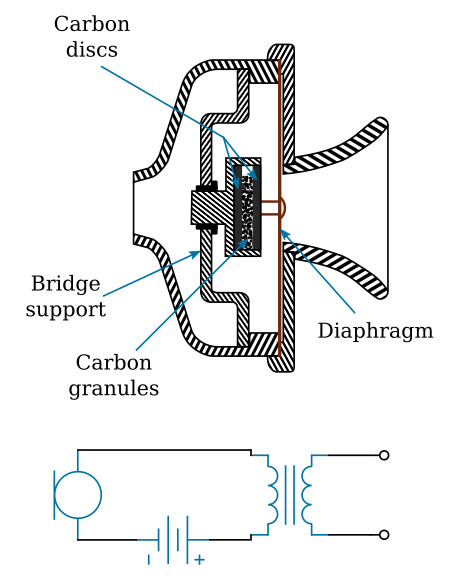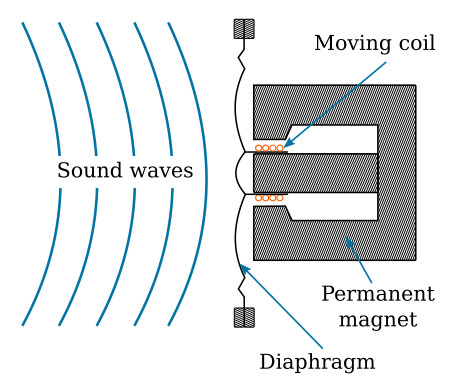Home > Textbooks > Basic Electronics > Transducers > Microphones >
Transducers
Microphones
A microphone is a device that transforms sound pressure into electrical energy. In most types of microphone the sound pressure acts upon a thin plate or diaphragm, setting it into vibration, and this mechanical motion is then utilized to produce electrical effects.
The sensitivity or efficiency of a microphone is usually expressed in terms of the electrical power level which the microphone delivers to a matched-impedance load compared to the sound level being converted. The sensitivity is rated in dB and must be as high as possible. A high microphone output requires less gain in the amplifiers used with the microphone. This keeps the effects of thermal noise, amplifier hum, and noise pickup at a minimum.
For good quality sound reproduction, the electrical signal from the microphone must correspond in frequency content to the original sound waves. The microphone response should be uniform, or flat, within its frequency range and free from the electrical or mechanical generation of new frequencies.

The symbol used to represent a microphone in a schematic diagram is shown in the figure above. The schematic symbol identifies neither the type of microphone used nor its characteristics. The basic types of microphone are described below.
Carbon Microphone
One of the earliest microphones depends for its action on the fact that the electrical resistance between carbon granules in contact with each other varies with the contact pressure. The figure below shows a simplified sectional view of a single-cell or single-button carbon microphone, as was used in some telephone sets. A small brass cup contains two polished carbon disks, one fastened solidly in the cup and the other attached to the diaphragm. The space between the disks is partly filled with carbon granules, and as the diaphragm vibrates in response to the sound waves striking it, the varying pressure on the granules causes changes in the electrical resistance between the disks. The microphone circuit is shown in the same figure, and from this it is seen that variation of microphone resistance will alter the current through the transformer primary, and so will set up induced voltages in the secondary.

By proper choice of diaphragm stiffness and mass, the moving system can be made to resonate near the middle of the speech range of frequencies. When this is done, the electrical output is large enough to operate a receiver over a considerable length of line without requiring amplification. The frequency response is then not very uniform, although it is entirely adequate for speech reproduction.
By using a very light diaphragm, tightly stretched, the frequency response is greatly improved, but at the expense of sensitivity. Carbon microphones with this type of construction, and having two buttons, or carbon cells, were used extensively in early broadcast practice.
Crystal Microphone
Another type of microphone depends for its action on the piezoelectric effect possessed by certain crystals, for example Rochelle salt. The term piezoelectric effect refers to the fact that when pressure is applied on the crystal in the proper direction, electrical potentials are produced between opposite faces of the crystal. The sound-cell type of microphone contains an assemblage of small crystals of this type, so connected that their piezoelectric potentials are in series. The sound falls on the crystals and vibrates them directly. The electrical output is quite small, but the frequency range and uniformity of response are excellent.
In another type of crystal microphone, a metal diaphragm is coupled mechanically to a crystal of Rochelle salt in such a way that vibration of the diaphragm causes a twisting of the crystal, and thereby the generation of a voltage at the terminals. This type has much greater output than the sound cell, but the frequency response is limited by the inertia and stiffness of the diaphragm and the associated driving members.
Dynamic Microphone
A cross-section of the dynamic or moving-coil microphone is shown in the figure below. A coil of fine wire is mounted on the back of the diaphragm and located in the magnetic field of a permanent magnet. When sound waves strike the diaphragm, the coil moves back and forth cutting the magnetic lines of force. This induces a voltage in the coil that is an electrical representation of the sound waves.

The sensitivity of the dynamic microphone is approximately as high as the carbon type. It is light in weight and requires no external voltage. The dynamic microphone is rugged and practically immune to the effects of temperature and moisture. The output impedance of the microphone is low.
Ribbon Microphone
The ribbon microphone operates in a similar way as the moving-coil unit, in that the ribbon represents the moving conductor. In this type the moving element is a very thin and flexible metal ribbon, upon which the sound waves act directly. It vibrates in a magnetic field, and generates an electromotive force on the ribbon. Both the output voltage and the impedance are very low.
Condenser Microphone
The condenser microphone is essentially a condenser (capacitor) formed of two plates separated by the air as a dielectric. One plate is fixed, while the other serves as the diaphragm and is caused to vibrate by the incident sound pressure. The capacitance across the two terminals thus varies in accordance with the sound pattern. A polarizing voltage is required, and is connected in series with the microphone by way of a high-value resistor which, irrespective of diaphragm movement, holds the charge on the microphone at a fairly constant value. Thus, as the capacitance alters in value due to sound pressure, the potential across the capacitor varies accordingly, since this is equal to the charge divided by the capacitance.






